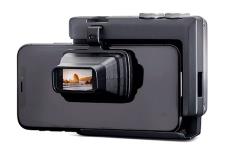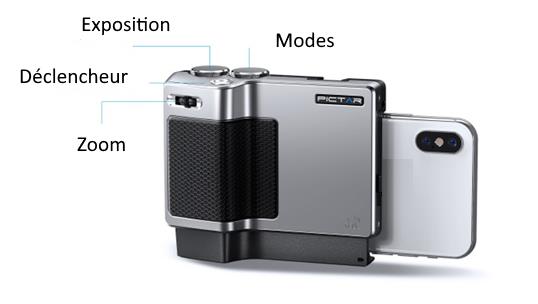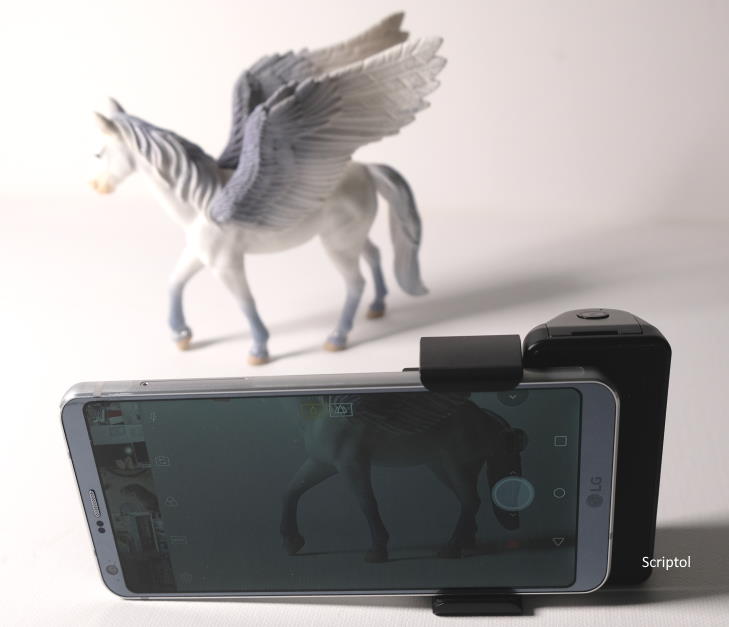How smartphones became cameras
The question arises whether expensive cameras and lenses will still be relevant in a few years, given the sales statistics (data at the bottom of the page)...
Smartphonecan have a housing and viewfinder
 The main obstacle to the smartphone completely replacing the camera is that the latter has the advantage of having a body, with a shutter, control buttons, and dial controls. Changing shooting modes on a smartphone takes a little time, and in order to capture the unique moments of life, you have to act quickly.
The main obstacle to the smartphone completely replacing the camera is that the latter has the advantage of having a body, with a shutter, control buttons, and dial controls. Changing shooting modes on a smartphone takes a little time, and in order to capture the unique moments of life, you have to act quickly.
Pictar Pro negates this advantage of the camera by offering a removable body that communicates via radio waves with the phone and thus can fire a shot, change modes, adjust exposure, etc. While this body is in development at the time of writing, it is not a pipe dream; the first version has been on sale since 2016, and this Pro version is just an improvement.
You can also use the viewfinder as an option, which becomes crucial when the anti-glare coating of the screen is not enough to counter the sun's rays.

Cameras also have the advantage of a larger sensor, but smartphone algorithms are great at replacing this sensor and lenses.
A similar initiative was made by a British startup with Alice (video), which uses a smartphone, its processor and artificial intelligence to control the body of a camera equipped with a standard Micro 4/3 mount. We will return to this device, which seems very promising, thanks to AI, when the product is available for sale.
Or a simple grip with a shutter

The handle shutter interfaces with the smartphone via Bluetooth. It is extremely easy to use and provides the same feel as the camera. On online retailers, it costs about €15!
The revolution of computational photography
Limited by the size of their sensors, half an inch or less, and the size of their lenses, smartphones owe the growing quality of their photographs to computational photography, which replaces algorithmic processing with optical processes .
This improves dynamic range by making all areas of the image sharp, whether light or dark, creating panoramas, and, above all, allows you to take photos in low light, at night or in low-light areas.
Equipped with a powerful processor, often supplemented by a GPU, smartphones can instantly perform deep computing and generate perfect images.
At the same time, cameras are struggling to keep up in computing power, equipped as they are with their own processors, in line with an economic model long accepted by all manufacturers.
The proprietary principle turns against manufacturers
For decades, manufacturers have relied on a fully branded production model. Everyone makes their own sensor, their own processor, uses a different mount and offers their own lenses adapted to this mount.
This economic model is the worst for the user: cameras are necessarily more expensive, and you cannot change brands without having to buy new lenses adapted to the brand mount. And there are a lot of fasteners...
But for manufacturers, this is the most profitable model; so many more lenses are sold and it makes even more money!
But the tide is turning. Now fewer and fewer cameras are being sold, and it is impossible to endlessly raise prices to maintain income! The economic pressure that manufacturers have been under since 2010 is forcing them to compromise, and Sony sensors are now found in cameras from several brands, including Panasonic, Olympus and even Nikon.
We even observe the computational principle of the arrival of smartphones in cameras, as well as artificial intelligence to improve autoFocus, HDR, panorama, high-resolution mode .
A little computationally in the cameras
The new smartphone sensors offer an impressive 64MP or even 108MP resolution. That's above what most cameras offer, whose technology is progressing at a much slower pace. And squeezing the market won't help unless Sony, using its expertise in smartphones, equips even more brands.
Previously, high-resolution images were already available on smartphones thanks to the composition process. This is called "Pixel Shift Shootout," "Pixel Shifting Resolution System," "Pixel Shift Multi Shooting," or "High Resolution." (high resolution).
This involves sequentially taking 4 or more images, each time shifting the sensor by one pixel, to artificially increase the number of photocytes collecting light and thus improve image quality. This process can also be used to increase resolution. HiRes mode reaches 240 megapixels on the Sony A7R IV.
High-resolution mode is also becoming popular among camera makers because it doesn't affect their lens-based business model, the same goes for panorama or HDR mode, but what about Night Sight mode?
Why aren't there Night Sight in the cameras?
The Night Sight algorithm was developed by Google for Android to allow small smartphones, less than an inch in size, to receive maximum light and replace the surface area of a large sensor with repetition. The principle involves very quickly obtaining a series of sequential images and superimposing them on top of each other to form a single, brighter and clearer image. Of course, the process was copied by all smartphone manufacturers. The result is amazing: night shots are better than high-end cameras!
These devices are equipped with so-called "full-frame" sensors to have more photocytes and capture more light photons, and their lenses have larger apertures to let in more light. And all this is very expensive.
Imagine that Night Sight was implemented on a compact camera with a one-inch or 1/2.3" sensor: it would become as powerful as the Sony A7, Canon R or other full-frame cameras. The entire upscale market, cameras and lenses, would have been wiped off the map.
Obviously we don't hear a lot of talk about Night Sight from manufacturers. Nobody even dares to talk to them about it.
Manufacturers have chosen the Luddite path: ignoring advances that could affect their earnings, even if that means allowing the industry to stagnate artificially in an outdated technological microcosm. Just as Kodak did in its day, delaying the transition to digital cameras so that people would continue to buy film and print photos (among other control errors).
The public then turned instead to digital cameras from Japanese manufacturers: Nikon, Canon, Fujifilm, etc.
This is probably still the same Luddite reflex that pushes manufacturers to ignore the possibility of adding applications to cameras that would have access to their internal processes. Who knows what improvements developers could add that would allow a cheap compact to become no worse than an expensive full-frame?
While Kodak has been crushed by rival manufacturers, the current manufacturers, as they all follow the same tactics, apparently have nothing to fear and can afford to force photographers to use the increasingly expensive equipment they offer.
Only on the surface, because there really is a competitor: a smartphone. And its photographic capabilities are constantly improving...
Users are increasingly abandoning cameras in favor of this compact object, which they always have at hand and which offers them an equivalent service.

The statistics speak for themselves
Between 2010 and 2018, global camera sales in all categories fell 84%, according to CIPA data.
The hardest hit are compact and bridge cameras, cameras that would benefit most from computational photography because of their small sensors, but which are least equipped with it. Sales of SLR cameras are falling by 12% every year, and this is accelerating in 2019. Users of the latter are switching to mirrorless cameras, whose sales are stable from year to year.
The first figures announced for 2019 are dramatic, with reports of a 20% drop in sales, due to the increasingly high cost of cameras (to offset the decline in the number of devices sold!) And the growing capabilities of smartphones.